| Srl | Item |
| 1 |
ID:
158977


|
|
|
|
|
| Summary/Abstract |
The rhino is going extinct due to poaching at a rate which far outstrips current law enforcement or conservation efforts to halt their decline. A critical aspect of counter-poaching failures to date is an inaccurate view of the nature of poaching as a crime. Rather than demand-side efforts, attacking elusive smuggling networks or expensive technical solutions like drones, this article notes how a quasi-military tactical approach of ‘combat tracking’ offers the best way to protect the species. Based on wide ranging interviews and fieldwork across dozens of parks in southern Africa, it demonstrates how the current restricted range of the rhino, and the rarity of skilled poachers, makes a tactical solution the most effective to date.
|
|
|
|
|
|
|
|
|
|
|
|
|
|
|
|
| 2 |
ID:
158973


|
|
|
|
|
| Summary/Abstract |
Central Asians have long been present within the ranks of organisations linked to the global jihad movement, but has there been an acceleration in their recruitment in recent years? There is growing evidence of substantial numbers of Central Asians (mostly Uzbeks and Tajiks) present in Syria in the ranks of the Islamic State and of a number of organisations linked to Al-Qaida. There is also growing evidence of recruitment inside Kyrgizstan and Tajikistan at least (as opposed as among Central Asian emigrants). The authors argue that distrust towards information provided by the Central Asian regimes should not blind analysts towards an emerging trend, which has substantial destabilising potential. The factors driving this recruitment also seem to be much more complex than a rejection of the authoritarianism of the ruling elites.
|
|
|
|
|
|
|
|
|
|
|
|
|
|
|
|
| 3 |
ID:
158978
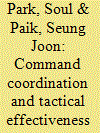

|
|
|
|
|
| Summary/Abstract |
This article analyzes the causes of combat effectiveness of the South Korean security forces through the course of its various counter-insurgency (COIN) operations from 1948 to 1953. We argue that improvements in two interrelated aspects ultimately resulted in higher operational and tactical level performance: unified operational command structure and the subsequent improvements in tactical efficiency under the guidance of the US advisory mission. Through an in-depth case study on how a nascent army improved its capacity in combating homegrown insurgencies, we demonstrate how the actual conduct of operations itself remains just as significant in the assessment of overall COIN outcomes.
|
|
|
|
|
|
|
|
|
|
|
|
|
|
|
|
| 4 |
ID:
158979
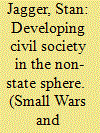

|
|
|
|
|
| Summary/Abstract |
Armed groups are usually seen as threats to humanitarian action but less attention has been paid where they provide assistance to constituent populations. Ethnic armed groups (EAGs) in Myanmar have developed associated welfare organisations that perform this role. This article argues this is due to EAG social embeddedness and flexibility to changes in sources of funding and support, and the influence of their relations with international humanitarian organisations. This article further contends a subset of advocacy, health and education organisations have evolved to form a nascent civil society within the political and social non-state sphere of some established EAGs.
|
|
|
|
|
|
|
|
|
|
|
|
|
|
|
|
| 5 |
ID:
158976
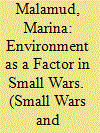

|
|
|
|
|
| Summary/Abstract |
This research paper analyzes the relationship between small wars, insurgency, and the natural environment. Existing literature and data are organized into four behavioral patterns: the resource-based wars accounts for the fight over natural resources; the warfare ecology paradigm refers to non-premeditated damage in preparation for as well as during and after conflicts; the environment as a target discusses intended attacks on the ecosystem; and the insurgency–climate intersection pattern denotes a deviation in climate change that increases the frequency of intergroup violence. The main premise is that small wars emerge when the ecosystem becomes a political asset.
|
|
|
|
|
|
|
|
|
|
|
|
|
|
|
|
| 6 |
ID:
158975
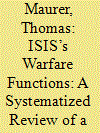

|
|
|
|
|
| Summary/Abstract |
This article gives an overall assessment of ISIS’s conventional conduct of combat operations by examining their warfighting functions patterns. In sum, the approach of ISIS comprised fundamental principles: their weapons can be organized into categories, purposeful combination of these forces in keeping with the concept of combined arms combat, and hierarchical command and control executed by experienced commanders. ISIS combat groups combined the elements of formation and firepower as well as movement and mobility. The paper concludes that ISIS obviously had a vast range of conventional capabilities at its disposal and was thus able to conduct major operations.
|
|
|
|
|
|
|
|
|
|
|
|
|
|
|
|
| 7 |
ID:
158974
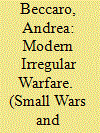

|
|
|
|
|
| Summary/Abstract |
ISIS (the Islamic State of Iraq and Syria) has become a key political and military actor in the Middle East and in North Africa. This essay aims at outlining ISIS warfare through an analysis of its operations in the frame of hybrid warfare theory proposed by Frank Hoffman. Therefore, the paper deals with: the role of terrorist tactics in ISIS warfare and the relationship between terrorism and insurgency; ISIS use of technology, mainly with regard to suicide attacks and to drones; and the relevance of urban warfare. Finally, the paper highlights how ISIS operates and the most threatening features of its warfare.
|
|
|
|
|
|
|
|
|
|
|
|
|
|
|
|
| 8 |
ID:
158980
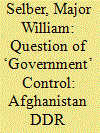

|
|
|
|
|
| Summary/Abstract |
Since the fall of the Taliban in late 2001, the Islamic Republic of Afghanistan (GIRoA), the United States, the United Nations, and the International Security Assistance Force (ISAF) have funded and led three different Disarmament, Demobilization, and Reintegration (DDR) programs. Despite a significant investment in time and treasure, all of them have failed to significantly reduce the number of insurgents or arbaki (militia). This article explores why these programs failed despite incorporating ideas from the prominent DDR schools of thought. Utilizing Stathis Kalyvas’ theory of The Logic of Violence in Civil War as a lens, this article argues that GIRoA and ISAF did not have sufficient control of territory to entice insurgents or arbaki to reconcile and/or reintegrate with the government. Further, in areas GIRoA nominally controlled in northern and western Afghanistan, regional powerbrokers who controlled these areas balked at these programs.
|
|
|
|
|
|
|
|
|
|
|
|
|
|
|
|